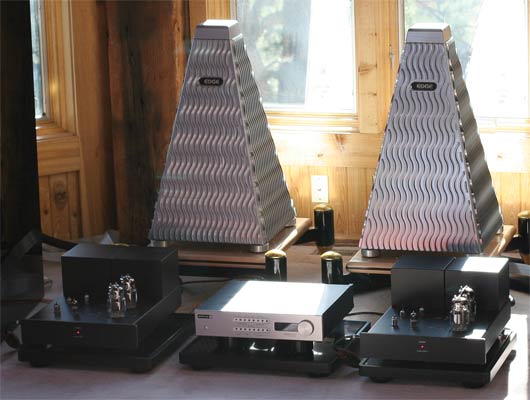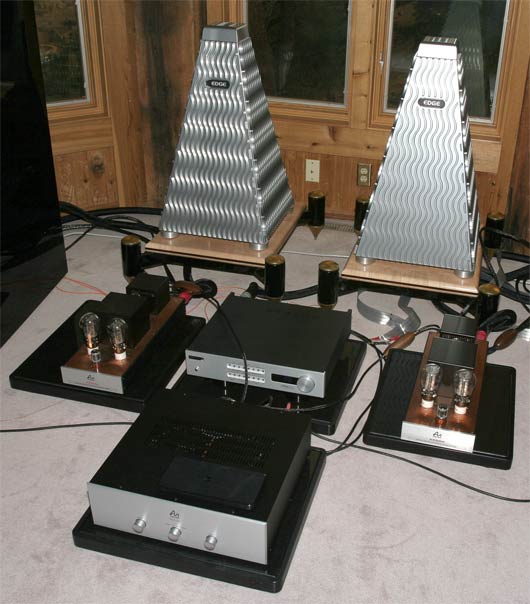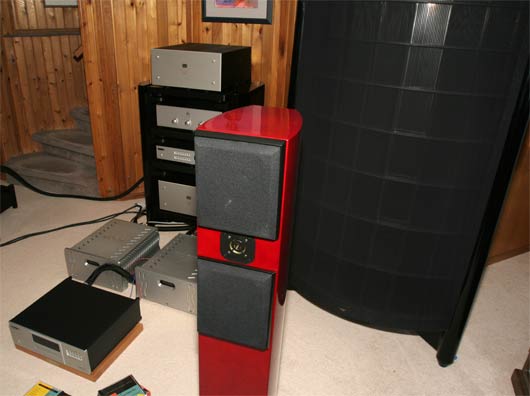By the wagons we got the Shunyata Anaconda Helix Alpha.
By the well we got the Elrod Signature 3.
and By the barn we got the Pranawire Satori.
OK. Ready. Set. Play!

The system we compared them on was the following: Kharma Mini Exquisite loudspeakers, Edge Signature One amps, Lamm L2 linestage, and EmmLabs DCC2 SE / CDSD SE CD / SACD front end. INDRA interconnect between the DCC2 and the L2, Valhalla between the L2 and amps, and Jorma No. 1 between the amps and speakers.
We tried out all 3 power cables on the Edge Signature One amps.

1.
First up were the Shunyata Anaconda Helix Alpha (who win the award for the longest name). Usually we like the Shunyata Anaconda Helix Vx cords better than the Alpha cords on the Edge, and now was probably no exception, but the Vx cords were on the Audio Note M10 linestage power supplies on a different system… so…
We played the first track on Radiohead Amnesiac. My thought when it was all over was that nothing was going to beat this – the resolution and imaging and ‘techno feel’ was first rate. And I was right, as far as it went, that nothing did beat them in these categories – there are other categories however… always more categories…

Photo taken after the shootout. Here we see the power cables with the red label (Shunyata Anaconda Helix Alpha), the green label (Shunyata Pyython [sic, WordPress has a bug that does not allow this to be spelled correctly, since this is also the name of a computer language it is confusing the poor thing…] going to the Soundlab speakers – not in the shootout), gray label (Shunyata Anaconda Alpha that were powering the Emmlabs), the silver-braid shielded power cords are the Pranawire Satori, and the big (but not as big as their brothers!) Elrod Signature 3 power cords. Oh, and the cords that look like red and blue stripes is the Valhalla going to the Lamm L2 linestage.
We also played Mark Knopfler’s Sailing to Philidelphia – first two tracks. [Pick this up if you like Mark Knopfler and high-quality music and sound – we’ve had many people who wrote the name of this CD down after hearing it here].
On the first track, Mark plays several licks that are up front and can be biting unless there is a lot of support from the system in terms of not just resolution, but harmonic integrity – the notes have to swell just right or they rise too fast and sound ‘bright’. It is in this respect that we prefer the Shunyata Vx cords on these amps – they handle the notes in a more relaxed, organic manner that seems to fit most of the music better.
2.
Next volley was heard from the Pranawire Satori. Pranawire has a trademark sound that is, what we call ‘psychedelic’ [or acid-like …including flash-backs] (and the Jorma Design Prime cable has some of this too, but in a different context, as do the Kharma loudspeakers). This sound is very very engaging – somewhat like 2A3 tubes in a good amplifier in that it is very subtle yet readily recognizable. Which is to say it does NOT distort the sound in order to entertain the listener in some kind of gross way by catering to the common human weakenesses for syrupy or euphonic sound.

It is a sound that is hard to describe – it is like adding ‘life’ to the music, or ‘color’ where there was none before but we were colorblind and did not know it. Anyway, with the power cords on the amps we heard this ‘effect’, which we have heard in their top-of-the-line cosmos speaker cable, but not so much in their cosmos interconnect. YMMV.
As for the sound, per se, solidity in the soundstage was better than the Shunyata for various instruments, accompanied by a reduction in resolution and – if I remember correctly (Neli is at the gym) a reduction in mircodynamics and air but an increase in the ability to swell dynamics from one state to another.

In many ways this was similar to going from solid-state to tubes – it is a tradeoff and depending on you and your system, you may or may not like it. I liked it, and certainly from the point of view of being a system builder: now I could add this ‘sound’ without having to deal with the somewhat large Cosmos speaker cable – which had some other side-effects – or having to swap out amps of source components or anything. I.E. swapping powercords for for the listener [who might be us!] who wants something a little more engaging (albeit a little less real) at the moment is now as easy as switching a power cord or two.
Radiohead’s voice and Khopfler’s guitar were all wonderously colorful and alive – there was however some reticience in the transition from one note to the next which we interpreted as probably resulting from these powercords being not quite burned in yet. [If you have been following the Blog lately, you might understand how we are growing impatient waiting for things to finish breaking in around here… 😉 ]

3.
The Elrod mosey’s in with the shotgun.

The sound of these was surprising to me … more detail (though not quite as much as the Shunyata Alpha) and much more separation – the soundstage really cleared up. The solidity was about the same as the Pranawire (the Anaconda Alpha had better pinpoint imaging than either – but it was not as 3D or ‘solid’). The Shunyata Anaconda Helix Vx has been our reference on these amps – and will continue to be so as it has performed well in 100s of system configurations we have set up – but the Elrod Signature 3, which we are learning more and more about, did much of what *we* like in a system, which is walk that fine, fine edge between real and musical. It entertained our minds, fooled our minds, and warmed our hearts (though that last not quite as aggressively as the Satori 🙂 )
4.
As a final test, we replaced both the powercords that were powering the Emmlabs transport and DAC with the Satori, they were what I think are from the photos Anaconda Vx (not the new Helix) . Could we hear the Pranawire effect even with the cords on a low current device like the digital front end?
The asnswer was yes, but it was only about between 15 and 25% of the effect it had when on the amps, in my estimation. It also clouded up the soundstage some,,, I think. It was weird. Maybe I was too tired at this point. Instruments and voices just sort of appeared in the soundstage, solid, but then faded from view somehow. It someway this was much more REAL than anything I have heard before in terms of what happens when a musician plays something then stops for a few moments. Or it was totally wacky and unnatural as the msucians did not seem to be in the same universe – much less in the same studio – but who knows, maybe they weren’t.
Anyway, more experiemtation is needed with mix and matching of these cords together in various systems.
Finale.

Acrolink burning in on the Winter burn-in device

So. We didn’t get to hear from the Shunyata Anaconda Helix Vx, nor from the Valhalla (which is on the Lamm L2 in this shootout – but we do not usually put it on the Edge, but in a shootout, ANYthing can happen 🙂 ), nor the Acrolink 7N power cords (which in some ways are the ultimate powercord, having both most intensly detailed resolution we have heard in a PC along with an even handed approach to harmonic body).








